Trout Hook Size: Full Article
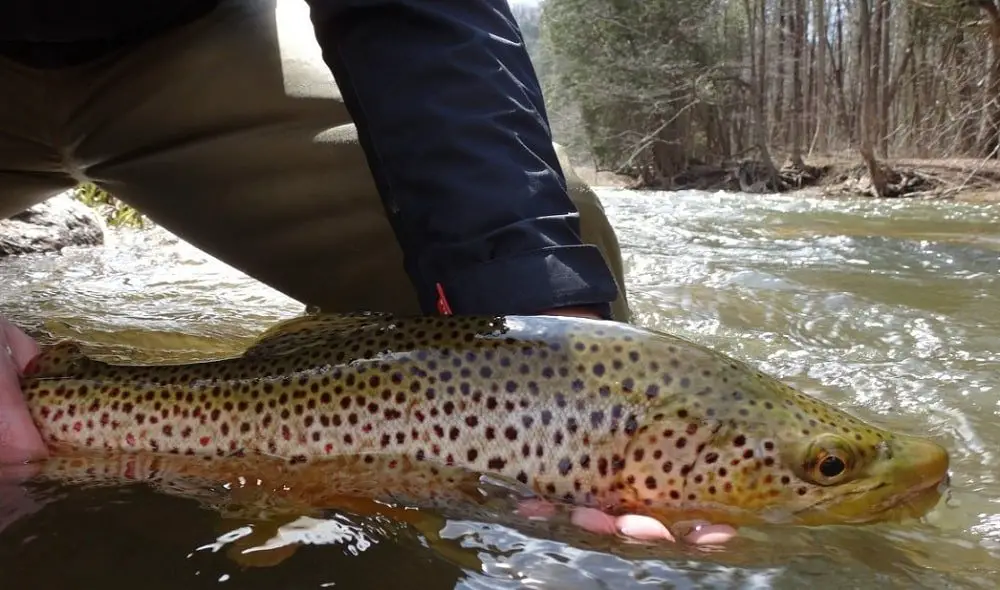
Have you ever wondered which hooks and which hook sizes trout fishing guides use? I checked with my guides to find out what they say the best hook size for trout is, what hooks they use, and why.
Let me tell you that after fishing for trout for 37 years and guiding for 22 years, the hook size you use matters, and the wrong hook size can limit how many bites you get.
We also find out the answer to the question, “does hook size actually matter, and if so why and when?”
It is said that the best hook size for trout fishing is size 8 to 14 single hook, but that is a wide range of trout hook sizes and just picking any hook in that size range could be a mistake.
Trout guides will tell you the true best hook size for trout actually depends on the size of the bait you are using, or the size of the trout that you are fishing for, and it could also depend on the river conditions. Often, the best size will be in that size 8 to 12 hook size.
I can promise you this, a good trout fishing guide doesn’t just randomly pick any hook in the 8 to 14 size range. I know this because I have been a guide for 22 years, I have trained plenty of river guides, and have had the pleasure to work with and learn from plenty more.
Did you know that a size 12 and size 14 hook is often a mistake that will cause my clients and you to lose more fish?
Did you know that a size 8 hook might prevent fish from biting in the first place?
Therefore hook sizes for trout fishing should be chosen carefully and for the right reasons, and I will try to explain this in an easy way.
2 Types Of Hooks For Trout Fishing
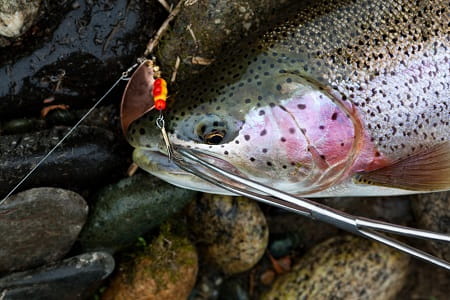
Before I get into the best hook sizes for trout you need to understand that there are two types of hooks for trout fishing.
There are actually lots of different types of hooks which I’ll discuss below, but the two primary ones are the single hook, which is one point, and the treble hook, which is three points.
Treble hooks are primarily used on lures and single hooks are primarily used for bait fishing.
Treble hook size and treble hook gauge is often decided for you by the lure maker.
A treble hook that is too big may affect the action of the lure, and smaller treble hooks, especially ones that are too small may affect the hooking ability of the lure.
If you decide to change the treble hooks on your lures it is usually recommended that you stick with the same size treble hook. Even the treble hooks gauge, which means the thickness can be important. You don’t want a thin gauge treble hook for trout fishing for huge trout or they might bend or break the treble hook.
At times, anglers will use treble hooks and put a big bait or a large worm on the treble hook but you will rarely if ever see a guide use treble hooks for trout fishing with bait.
The main disadvantages to using treble hooks and bait together are that the trout might see the hook or the trout might swallow the hook too deep and you will need to kill the fish to remove it. Treble hooks are tough to get out and for this reason, they don’t make good trout hooks.
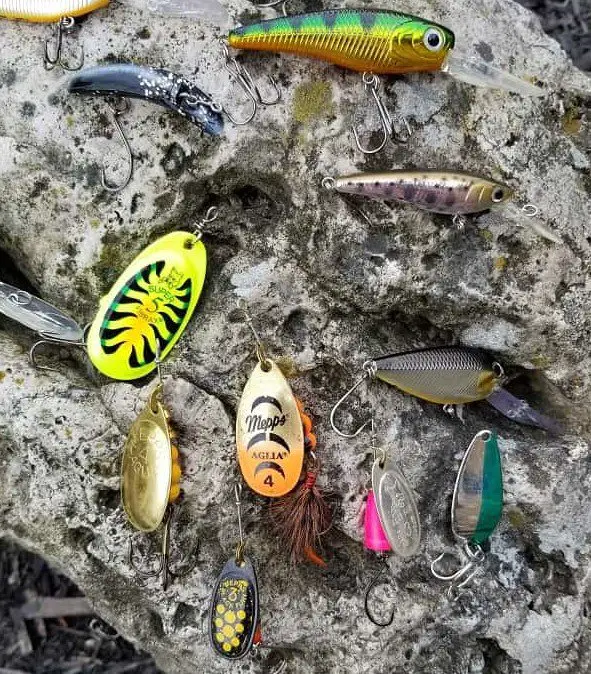
Some lures will even have two or three hooks which are usually three treble hooks and which means 9 points total, and 9 barbs which can make hook removal very difficult. Some anglers will even replace the treble hook on their lures with a large single hook.
My recommendation is to only use treble hooks for fishing and use single hooks for bait fishing. For more on fishing lures, check out my page Fishing Lures For Trout.
Guide Tip: if you are going to use treble hooks be sure you have strong fishing pliers, preferably needle nose pliers.
Choose Your Trout Hook Size Wisely
Not all hooks are good for trout!!
There are many advantages to using the right size hooks for trout but there are also some disadvantages to the wrong trout hooks, as well as the wrong trout hook shape, and even the wrong hook color, which can all lead to a no-fish day!
I have seen plenty of fish turn away from a bait, but with a few hook adjustments, I have seen that same fish grab the bait.
I have also put in thousands of hours testing baits, testing hooks, and testing different methods for catching trout, and I believe I have come up with the best hooks for trout which include the best sizes and shapes for trout under all conditions.
Below I provide a link to an underwater video of trout grabbing baits that are on bad hooks and you can clearly see that many trout are able to spit the hook out easily or they get off a lot after the hook set.
This clearly shows the results of bad hooks, the results of using bad baits, and the results of poorly rigged hooks. Don’t be this guy!
Single Trout Hook Types
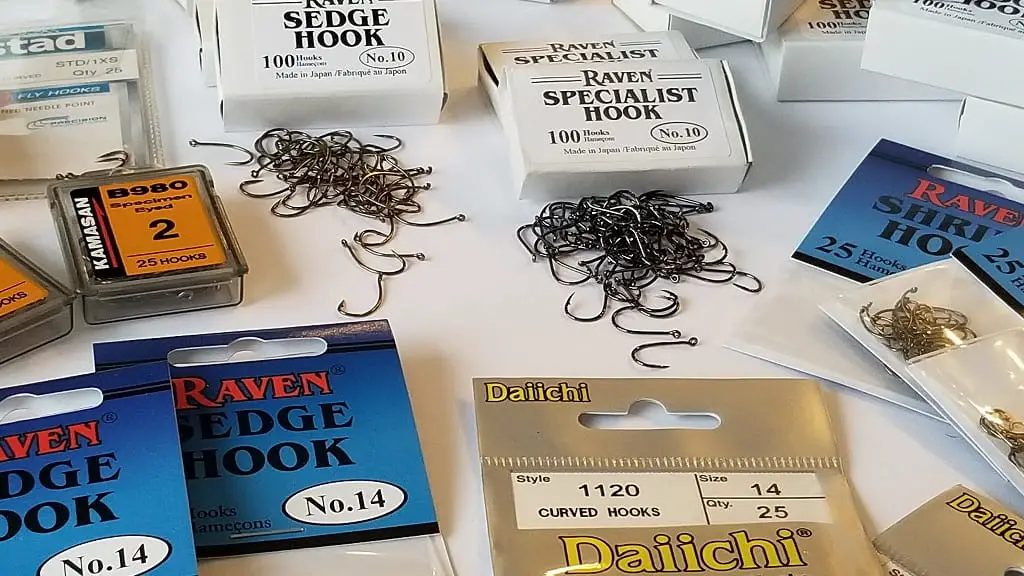
Hooks come in many shapes and sizes and this is because the shape of the hook is supposed to serve a purpose. Truthfully, 2 shapes of hooks are all you need and all good guides will use these.
The reason trout guides all use the same hooks is that we learn from other guides, we test hooks, we catch a ton of fish, and we see how these hooks perform. If you are not using the same proven hooks that guides use you are probably going to miss fish.
You are going to get varying opinions on the best hooks and hook sizes for trout from anglers and even authors of other articles on the internet, but, most of those guys are not experts.
As an example, I just read the top two articles on this topic and they recommend hooks I would never use, and hooks that I don’t know any trout guides that would use either.
These articles also recommended baits like corn and rigging hooks in ways that guides would never do, in fact rigging hooks in ways that will actually prevent you from catching trout. As soon as I read any article that tells anglers to use corn, they lose all credibility!!
Guide Tip: Guides and top trout anglers NEVER use corn. EVER!! And neither should you!
Below is a list of hook types and I will give you my honest and educated opinion on each.
Also, these hooks are also barbed hooks and they are meant for freshwater fishing.
Saltwater hooks are not a good idea for trout for a few reasons, therefore stick with freshwater hooks that are preferably bronze or black in color.
Baitholder Hooks – Don’t Use Them
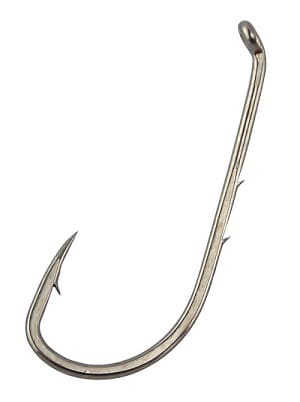
Baitholder hooks are often the most common hook used by inexperienced trout anglers.
The reason for this is because of the name “bait holder” which implies it’s good for holding bait.
But, the truth is, baitholder hooks are not good hooks for trout!!
You will not find good guides using baitholder hooks as their go-to hook for trout fishing.
This hook is designed for dead baits, artificial baits, and for live bait fishing for multi-species, but I would never use them for trout.
Bait-holder hooks are different than others because they have 1 to 3 barbs on the upper part of the hook shank which are supposed to hold the bait in place. This is an old design that needs to be retired permanently.
The concept is good, but the J-type shape of this hook and the narrow gap makes this a poor hooking and holding hook for trout fishing.
J Hooks
Similar in shape to the baitholder hook above is a J Hook. The main difference is there is no barbs on the hook shank.
This J hook shape is also not a good trout hook for bait and J hooks are only used in fly fishing to get the elongated body shape when they are used to tie mayflies and other dry flies.
They will catch trout when used properly as flies in fly fishing, but I would not recommend them when using bait.
Circle Hooks – Never Use Them For Trout
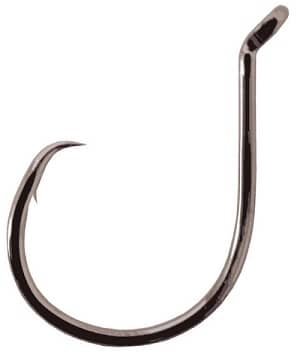
A Circle hook is said to hook the fish itself by spinning and grabbing the corner of the fish’s mouth when the fish inhales the bait.
However, I do not recommend circle hooks much because you need to use a pretty big circle hook for this self-setting action to work well, and often, we use small baits, and trout are hook shy so they won’t grab a bait with a giant circle hook.
Never use a circle hook in trout streams or for very small brook trout or rainbow trout.
You also can’t set the hook very well with circle hooks due to the hook point being curved sideways, so circle hooks do not work well for methods like float fishing or drift fishing/bottom bouncing which are the two most effective methods of trout fishing with bait.
If you fish largemouth bass with bait, or other species with a large mouth, then maybe a circle hook is worth a try.
Kahle Hook
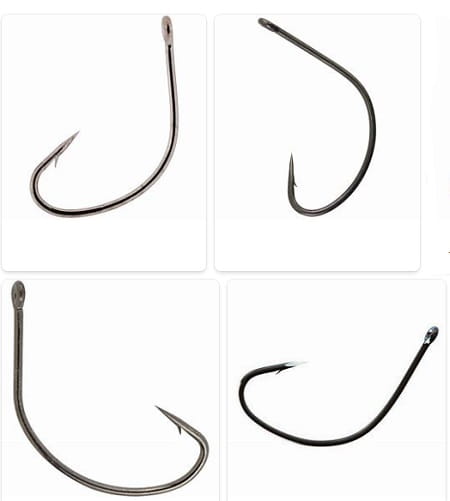
The Kahle hook is a cross between a circle hook and a J hook.
It should never be used for trout because it does not penetrate well due to the angle of the point.
It may hold well due to the shape but holding well means nothing if you don’t get the hook set properly in the first place.
Guides DO NOT use the Kahle hook and you should not either.
Like Circle hooks, avoid this type of hook.
Double Hooks – Do Not Use For Trout
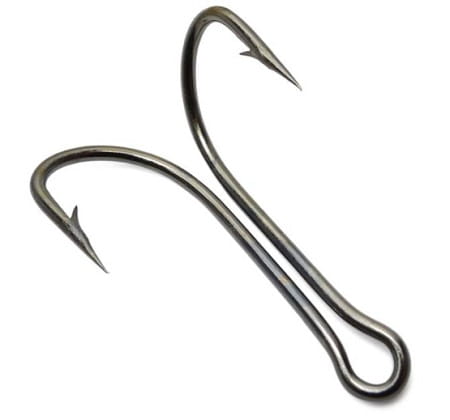
A Double Hook is basically two hooks joined at the eye and is often used by fly tyers that fish for Atlantic salmon.
Unless you are tying specific fly patterns that require a double hook this is not a good hook for trout fishing.
Double hooks are generally large hooks and made for streamer-type flies and not for bait fishing hooks, with the exception as some anglers will use this for trolling with baits.
I do NOT recommend double hooks for trout fishing.
Barbless Hooks
I do like barbless hooks for trout, steelhead, and salmon. Barbless hooks tend to have better-hook-setting penetration but some anglers worry that the trout will get off easy.
In my experience, very small trout tend to shake off easier on barbless hooks, which for me is OK because I would have released that trout anyways.
Larger trout do not shake and twist the same as small trout do so long as you keep the tension on the line the hook should stay in.
The other advantage to the barbless hook is it does NOT harm the fish as much as a barbed hook when removing the hook. This is a great thing when release fishing trout.
For smaller brook trout, and any fish with relatively small mouths, I always buy barbless hooks and use barbless hooks when possible.
Barbless hooks are not always easy to find especially in the styles of hook I prefer. You can also pinch or sand down a barbed hook to make it a barbless hook which is often what I and other guides will do.
A barbless hook is also good for single salmon eggs, egg sac fishing, live bait, and is used a lot for fly fishing.
A Barbless hook is good for any size trout.
Octopus Hooks and Specimen Hooks: Best Hooks For Trout
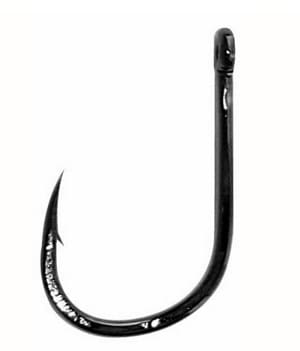
If you look into a trout guides pack or fishing vest you will likely see an assortment of sizes of Octopus hooks and/or the similarly shaped Specimen hook.
The reason is that these are often the best single hook for trout.
They are short shank hooks with a wide gap, even in the smaller hook size.
This shape provides better hook penetration with less leverage on the hook in the trout’s mouth so the trout are less likely to pry it out.
These fishing hooks also grab more flesh due to the wide gap, and they tend to hold better.
The wider gap also allows the hook point to stay unobstructed when using bigger baits. A non-covered hook point will result in more trout hooked.
These hooks also tend to have and medium to thick hook wire gauge which is why they work best for trout, steelhead, and salmon anglers.
Sizes 8 to 12 Octopus hooks and Specimen hooks are the BEST and if I had to choose, I would say a size 10 is the best size hook for trout.
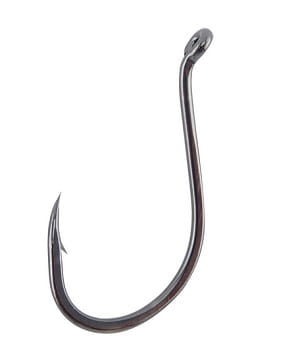
It’s not easy to buy barbless hooks in this shape so if you want Octopus and Specimen barbless hooks for trout fishing just pinch the barbs yourself.
Remember that in some areas, barbed hooks are illegal.
Even most of the west coast salmon anglers and top guides use these hooks, just with bigger hook sizes.
Egg Hooks – Good For Single Salmon Eggs
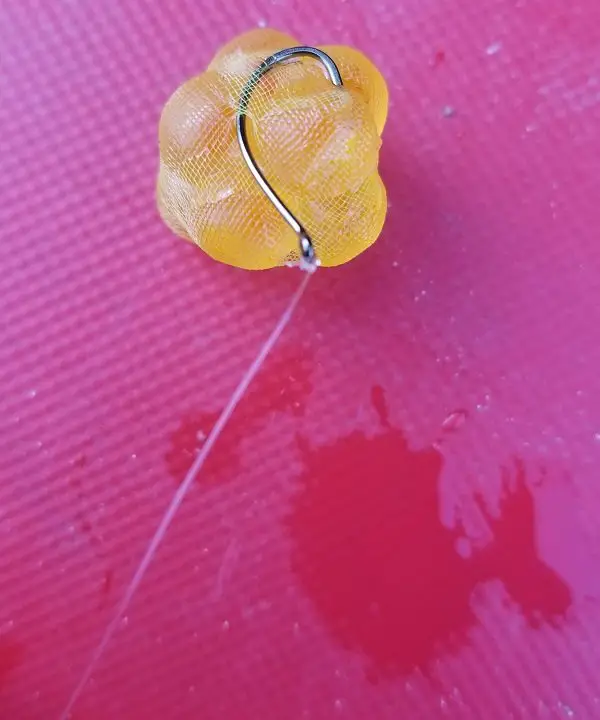
Egg hooks are about the same shape as most Octopus and Specimen hooks and are promoted and sold as specialty hooks for rigging single salmon eggs or for egg sac fishing.
I don’t use them because I already use Specimen hooks which are similar and work well for salmon eggs, but egg hooks are still a good single hook choice for trout fishing.
One benefit of salmon egg hooks is they can come in very small sizes up to size 16 so you can bury the hook in the salmon egg, however, in my opinion, even for small rainbow trout, a size 16 is just too small and I would recommend a size 12 and 14.
Remember, a good size hook for trout is one that fits the bait too, but too small makes it harder to hook the trout and won’t hold as well.
Sedge Hooks – Good For Stealthy Presentation
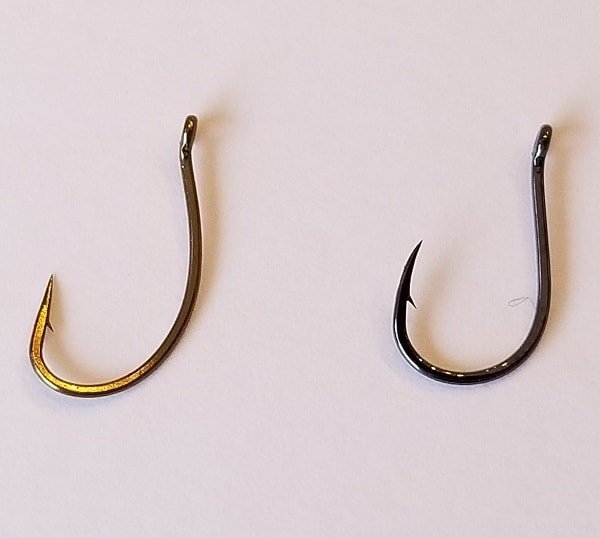
Sedge hooks are my second favorite single hook for trout fishing. A size 8 to 12 is a good size trout hook.
The sedge hook is the hook type I use when I want a stealthy hook that holds well and I also use it with light fishing line.
The Sedge hook tends to be a lighter wire hook which the trout don’t see as easily, and because it is light it allows for a more natural presentation of your bait.
I have used the Sedge hook for all size trout and even steelhead up to 10 pounds, just be sure to use the appropriate size hooks for the fish size.
My two favorite sedge hooks are the Raven Sedge Hook and the Daiichi 1150 sedge hook.
Similar to the sedge hook is the Gamakatsu Trout Worm Hook which is also an OK hook for trout.
Trout Hook Sizing: Numbers and Aughts
The hooks are measured using a numbering system. The numbers from 1 to 26 with the larger number being the smaller hook and a smaller number being the bigger hook.
I’m not sure why it’s done this way but I think they did this to confuse the crap out of new anglers 🙂 Just kidding.
A size 24 hook is less than a 1/4 inch long which is really small and a hook this small would likely only be used by the odd fly tier to tie midges or mosquito patterns, but, hooks this small are sometimes used for trout.
A size 1 trout hook on the other hand is about an inch long and is meant for much bigger baits and bigger fish. A size 2 hook, is smaller than a size 1, and a size 3 is even smaller.
There are also hooks bigger than a size 1 and they rate them like this 1/0, 2/0, 3/0, and even much bigger with some over 8/0 for musky and saltwater fishing. A 1/0 hook is smaller than a 2/0. Anglers will often call a one-aught hook.
The Aught scale starts where the number scale leaves off. If you were considering bigger and bigger hooks, a size 1 hook would be the biggest hook on the number scale, but, a 1/0 hook will be the next biggest size, a 2/0, slightly bigger, 3/0 bigger, and so on.
The hook size that I use the most for trout is a size 10 but when I go trout fishing I have trout hooks with me from size 6 to size 14 because there are times when a size 10 is too big or too small.
Trout Hook Size By Brands and Types
The number sizing is not universal sizing so a size 10 Owner hook could be a different size than a size 10 Raven hook.
As well, a baitholder hook might be different in size than Circle hooks, or egg hooks.
Hook Guage: Thickness Matters
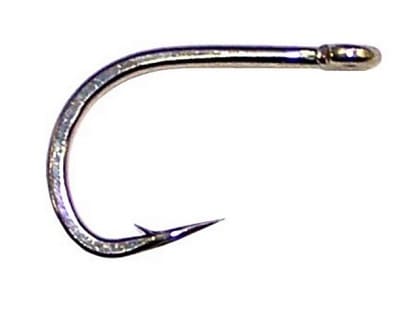
The hook gauge, also known as hook thickness is often directly related to the hook size. A size 14 hook will be much thinner than a size 8 hook.
This is one of the reasons why you should consider not using a size 14 hook. A size 14 hook might bend or break on big trout.
On the flip size, a size 8 hook might be too thick and that can make it heavy which can make for a less natural presentation and might cause you to drag the bottom and snag more often.
If you have read any of my articles on presentation and how to catch more trout, steelhead, and salmon, then you know I advise not to drag your bait on the bottom of the river.
There are some advantages to big, and to small hooks.
The Difference Between Hook Sizes

I would consider a large size hook to be anything bigger than a size 6 hook. Even a size 6 to me is pretty big for almost all trout.
A large trout hook will be thicker, heavier, and stronger and has the advantage of hooking the trout and holding onto the trout better.
A larger size hook will be wider which will usually give you better hook penetration, and a larger hook will also grab more flesh so it will hold onto the fish better, but don’t let that be the reason you go straight to a big size 2 hook because if the hook is too big the trout may not put it in their mouth in the first place.
On the flip side, a small hook doesn’t grab a lot of flesh and doesn’t hook trout as well and is more likely to tear out of the fish’s mouth but a small hook in a bait is less likely to be seen by the trout and is more likely to get grabbed.
I use a larger size 6 or 8 hooks whenever I can, and I use a smaller size 10 to 14 hook when I need to. The key is knowing when to use the bigger hook and when you should use a smaller hook.
The Hook Size For Trout Depends On The Bait
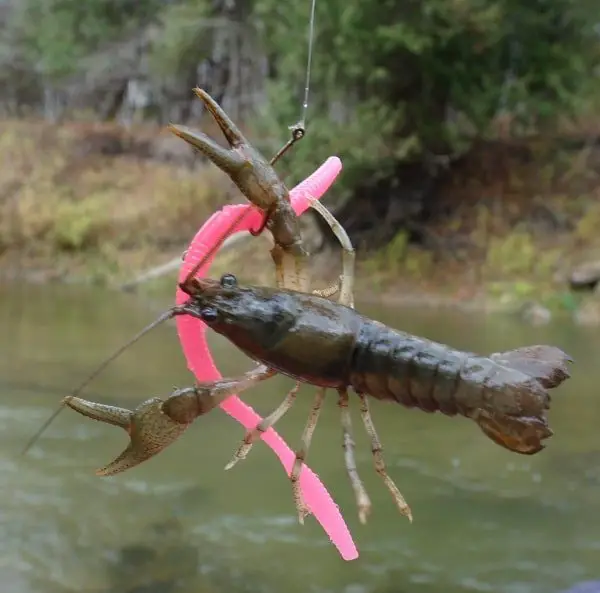
Bigger baits will require a bigger size hook and smaller baits will require smaller size hook. In case you are wondering, I was using a size 10 Raven Sedge hook when this Crayfish grabbed it and got itself hooked.
There are many reasons why your bait will dictate the best hooks size for trout fishing.
I believe that trout feed more based on sight than they do on scent or other factors so I adjust my hook size accordingly to make sure they don’t see the hook.
If they see your hook you will have a tough time catching trout, even rainbow trout which are less cautious can still refuse a large size hook.
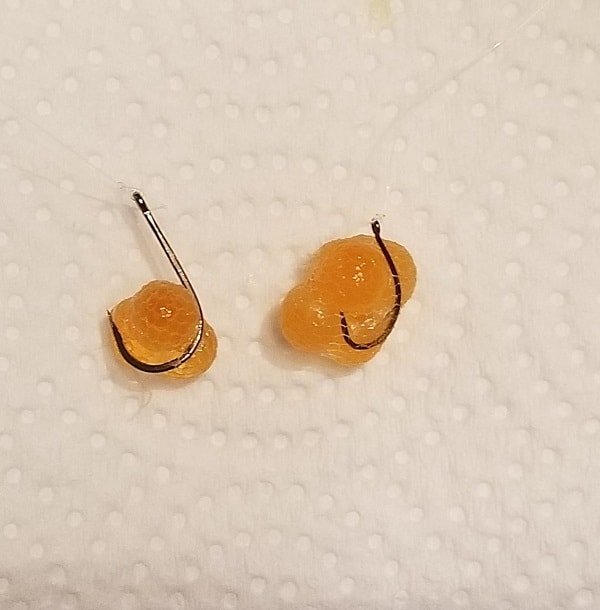
Wild trout that are feeding in clear water will be extra cautious so smaller hooks are better and a large size hook will mean fewer fish.
A hook that is too large for the bait will stand out too much and be ignored by the bigger wiser trout, especially under clear and slow water conditions.
A thick hook also stands out more than a thin hook does so that is something else to consider when choosing the best hook size for trout.
GUIDE TIP: If you want to see the wrong hooks and wrong baits in action, watch this video of trout grabbing baits underwater, and see how many times they spit the crappy hooks out.
Presentation Will Improve With The Right Hook Size
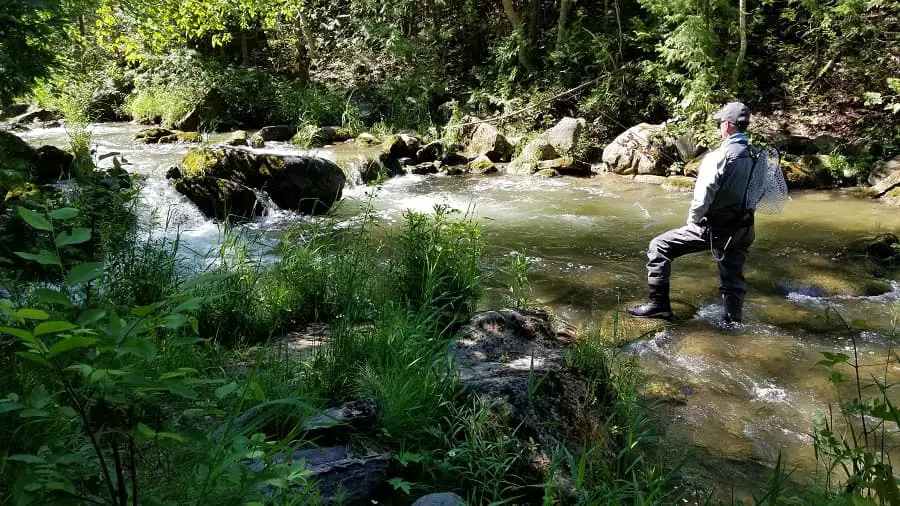
The right size hook for trout fishing can make a big difference in the presentation of your bait.
The right hook size for trout will improve your presentation. A size 2 or size 4 trout hook will likely be too large and will affect how the bait drifts through the current giving you a poor presentation.
If you have read any of my previous posts on how to fish for trout you will know that I think proper presentation is critical in catching trout consistently.
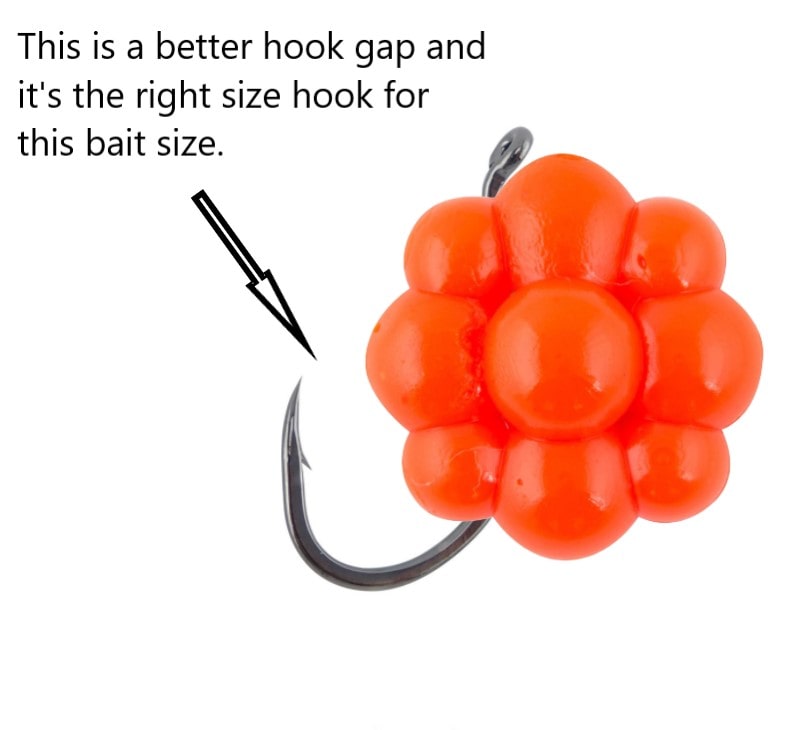
If you are not sure about how to rig your bait or how to present your bait effectively or you want a guide’s advice on the best methods for bait fishing check out my page on How To Float Fish and my page on How To Bottom Bounce Like A Pro.
A trout hook that is too big will not allow a small bait to move naturally in the current because it is too heavy and weighs it down. This looks unnatural to the fish and could be a warning signal to them.
A smaller size 12 trout hook will be lighter and allow the bait to have better and more natural movement which looks better to a trout and provides a better presentation but don’t go buying a bunch of tiny hooks just yet.
A heavy hook will also drag along the bottom too much which also looks unnatural to the trout because most bugs and other bait will drift freely on and off the bottom.
I also believe a hook constantly dragging along the bottom is a bad thing since trout tend to feed up or sideways 87% more than they feed down. That number is based on a recent study I read, but I have been saying this for over 20 years.
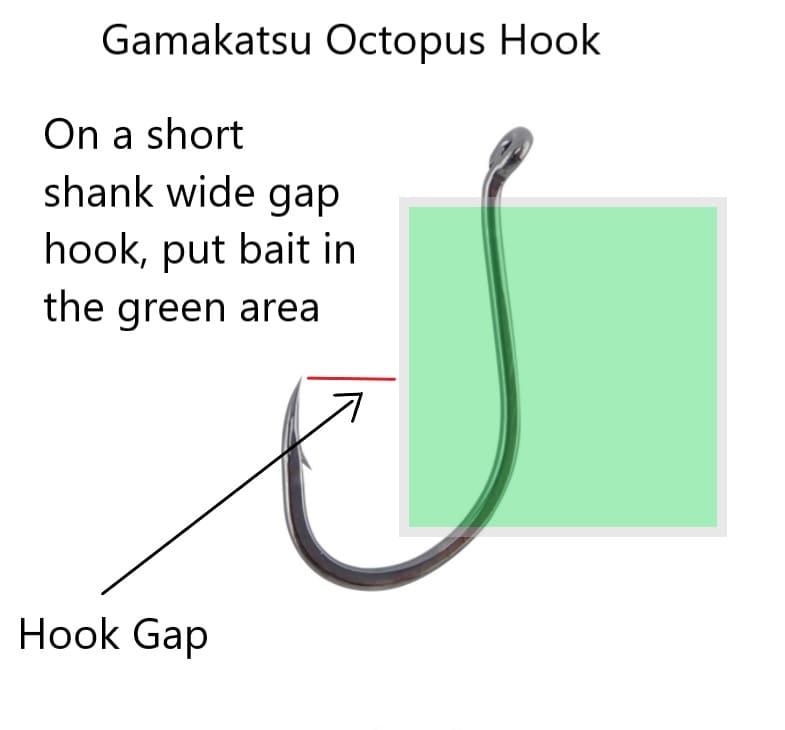
A hook that is very large and too heavy will also snag the bottom too much which means more lost hooks, and it also means you are more likely to have debris stuck to your hook during your drift.
Debris on the hook will prevent the trout from biting the hooks.
The problem with small hooks in size 12 to 18 is that a size 14 trout hook might be too small and will get buried in the bait which may close up the gap which will then affect how well the hook penetrates and how well or how poorly it hooks the trout.
If the hook gap is closed up or the point is covered by the bait you will miss a lot of trout on the hook set or the trout will pick up the bait, feel the pull or line and spit the hook out without you getting a hookset.
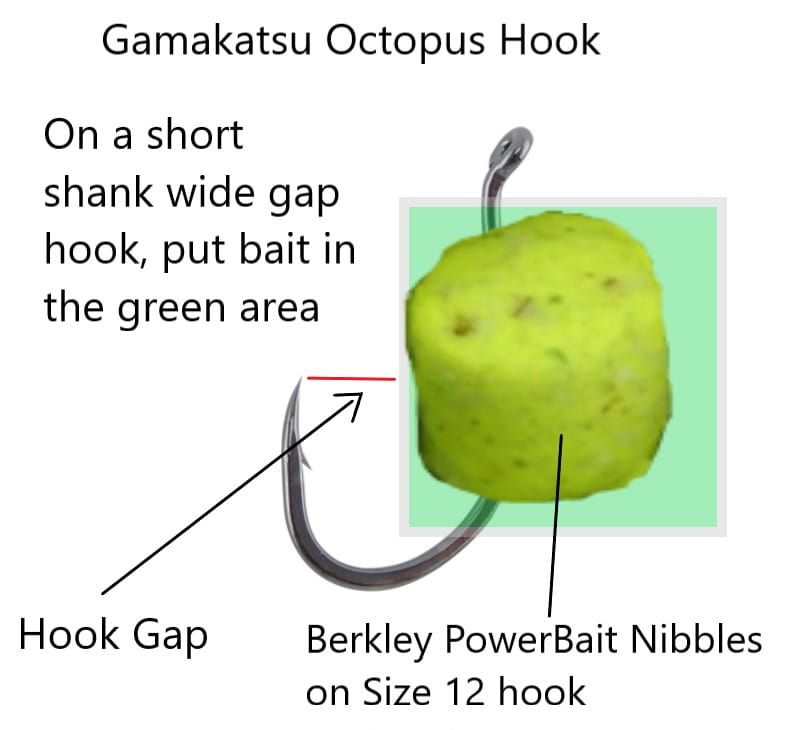
The best hook size for trout fishing when using a grub or a single salmon egg is a size 12 or maybe a size 14 trout hook if the water is very clear.
I would only go this small just so that the trout does not see the hook.
The best hook size for trout fishing when I am using a bigger bait like a garden worm or a spawn bag that is about the size of a nickel would be a size 6 or 8 trout hook.
But these hooks are bad when used with smaller baits.
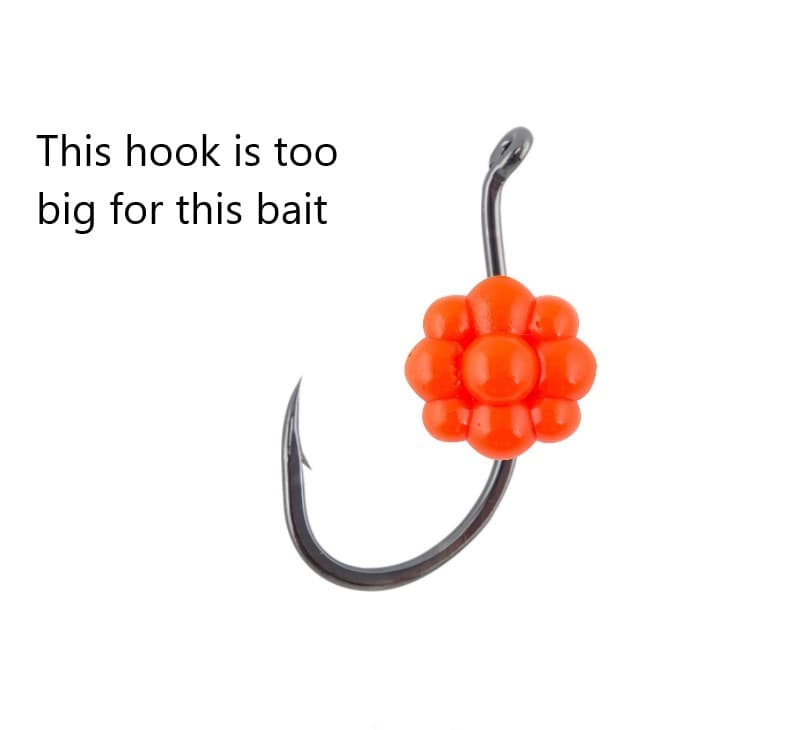
The best hook size for trout when using a very large bait like a chunk of skein, a crayfish or a dew worm, or even a large minnow would be a size 4 or 6 trout hook.
If you want to know what my favorite baits are for trout and my tactics for catching more trout on baits, go to my page called Best Trout Baits – The Only 5 Baits You Will Ever Need
Water Clarity And Hook Size For Trout
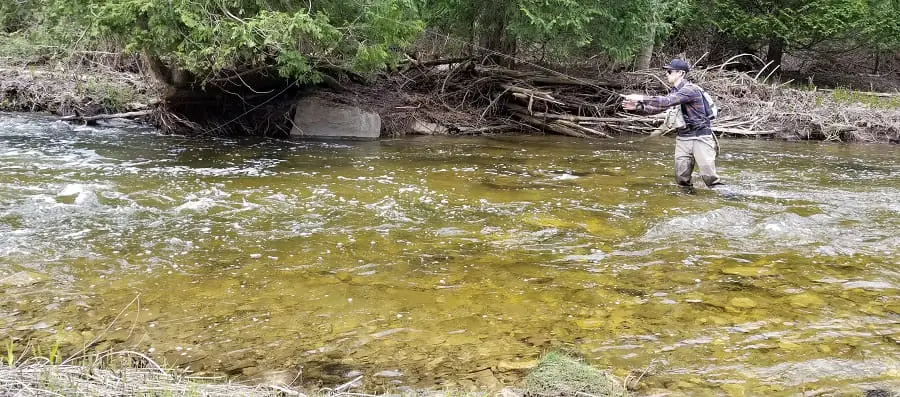
The the size of hook used for trout fishing will change based on the water clarity.
A bigger hook will hook more fish and will hold on better so if the water is dirtier and I think that the trout won’t likely see my hook due to the reduced visibility, I will use a bigger size 6 or size 8 trout hook.
If the water is very clear and I think the trout are more likely to see the hook in this clear water I will go with smaller trout hooks but only as small as I need to. In other words, I’m not going to put on a size 14 hook when a size 10 will still work.
A size 10 hook Raven sedge hook is a thin hook and in a 3-inch plastic worm, it will be hidden enough that the trout won’t see it even in very clear water.
Current Will Determine The Hook Size For Trout
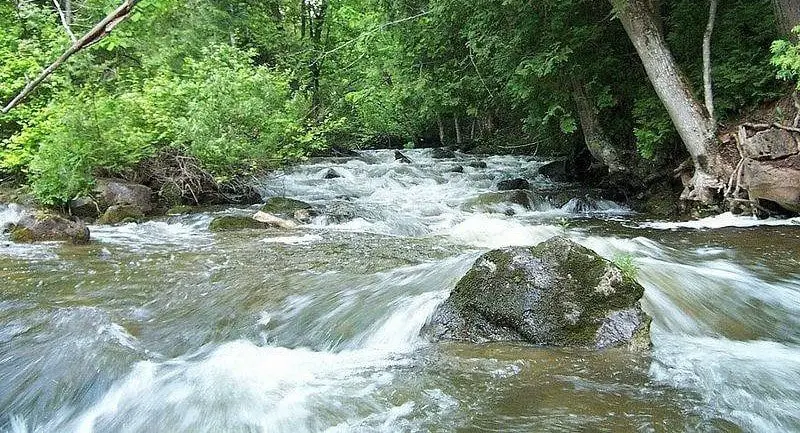
In faster water, the hook size won’t matter as much so I will often go with a bigger hook.
If the current is slow then the trout will have more time to inspect your bait which means they might see a bigger hook. In slower currents, the best hook size for trout fishing will be a smaller thinner hook like a size 10 to 12 trout hook.
In faster currents, the best hook size for trout fishing will be a bigger hook. If the current is fast the trout have to make a split-second decision when feeding which means they are less likely to see a bigger hook and since bigger hooks will hook and hold better I may go to a size 6 or size 8 trout hook in fast water.
The faster the water the less the hook size matters however almost never will I drop down to a size 2 or size 4. A size 6 will hook and hold a trout, steelhead, or even a salmon just fine.
The Right Hook Size For The Size Of The Trout
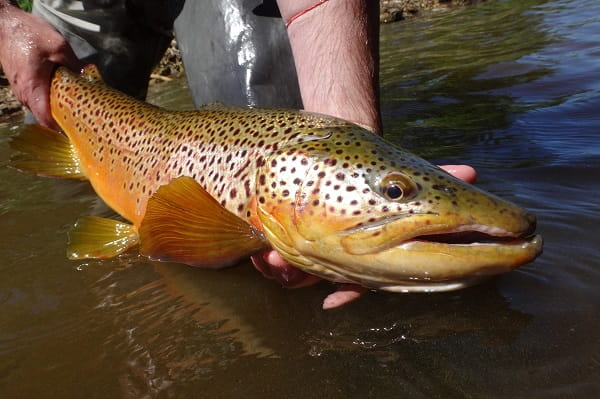
Some anglers think that you need a bigger hook for big trout and a smaller hook for small trout but that’s not true.
Whether the trout is 20 pounds or 4 inches they both see things the same way and they will both see the hook if it is too big.
For all the same reasons why I would or wouldn’t use a large hook will still apply to big trout or small trout.
In fact, sometimes I have to use smaller hooks for big trout just because they are much wiser than younger trout and they are more likely to be cautious of a big hook. But don’t worry because I have caught lots of 20 to 40-pound salmon on size 8 trout hooks.
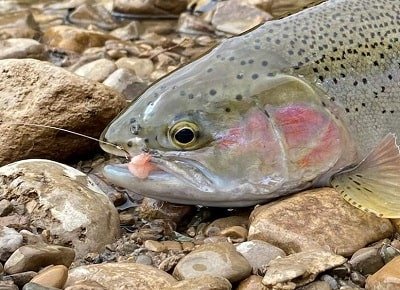
My go-to size when I am guiding for steelhead is a size 10 trout hook in clear water conditions, and I sometimes put over 300 steelhead in the net just in the month of November.
If a size 10 trout hook didn’t work for big fish over 5 pounds I wouldn’t be using it. If a size 10 trout hook is good enough for steelhead it’s good enough for trout too.
The size of the fish usually doesn’t matter, except when hook strength is a factor.
The only difference between a hook for a large trout and a small trout is the thickness of the hook. A Raven size 10 sedge hook is a thin wire hook that might straighten out on very big trout or on a big salmon, but a size 10 Gamakatsu Octopus Strong hook or the Raven Specimen hook won’t bend or break on bigger fish.
They are basically the same size hook but one is just stronger due to the thickness of the hook.
I will change my hook strength based on the size of fish I’m fishing for only if I think there is a chance the fish may break the hook or bend it.
Best Hooks For Trout Fishing
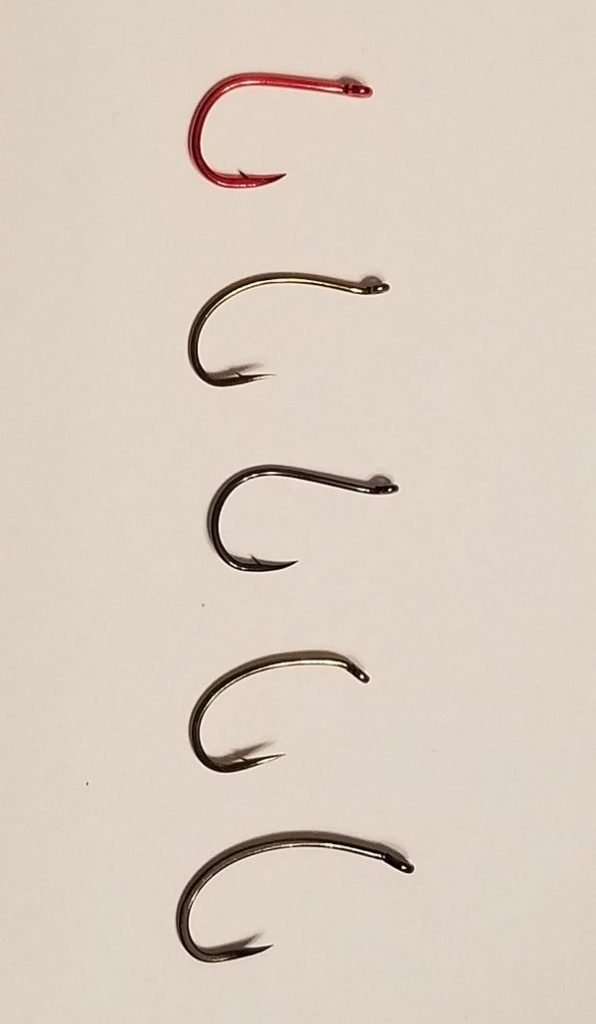
You’ve probably been waiting for me to finally tell you what the best hooks for trout fishing are, or which trout hooks I use and recommend to my clients, but that can take up an entire page, and it did, so go to my page on the 5 Best Hooks and enjoy.
If you don’t want to skip to another page, here is a quick summary of the best hooks for trout and the ones that I use the most for both trout and for steelhead.
- For small baits and in very clear water I will use a size 12 Raven Sedge Hook or a size 10 to 12 Daiichi 1150. I rarely go as small as a size 14 trout hook.
- For a good multi-purpose trout hook that is suitable for most river conditions and most bait sizes, and most fish sizes, Use the Raven Specimen hook in a size 10 and 12. This is the hook that I and my guides prefer the most because it tends to hold onto the fish well and penetrate well.
- If the water is dirtier and I can get away with a bigger hook or I am using larger baits, I will go with the Raven Specimen hook but in a size 8 or maybe a size 6 trout hook if it’s really dirty water.
- Another hook that I like in all these sizes and conditions is the Redwing Blackbird Sabertooth hook.
Leader Size And Hook Size For Trout
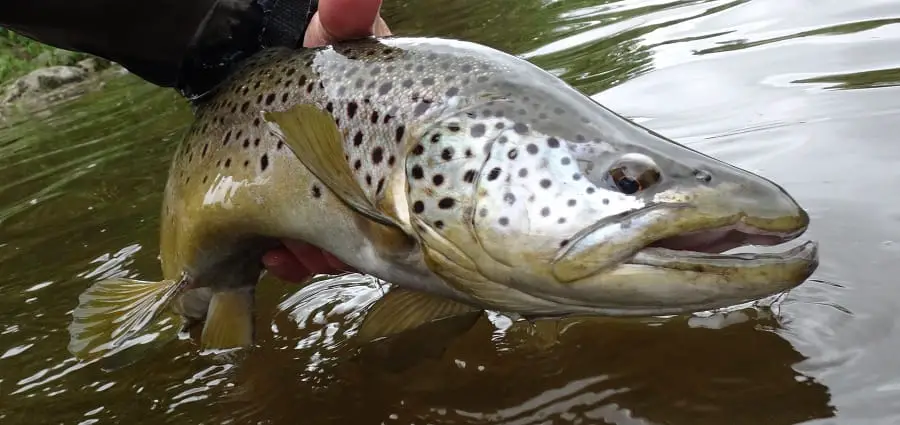
If your hook size is wrong, those big wise old trout will ignore it.
The size of your leader should also be considered when considering your hook size. This is something a lot of guys don’t think about when choosing the hook size.
Many anglers think they need and big strong hood because they are fishing for big trout. But trout can be line-shy and that means that a big strong hook will never be put to its full potential because the chances are that the lighter leader will always break long before the hook will bend or break.
If you want a big wise old trout to bite, you need a leader and a hook size that they won’t see.
One of the reasons that I use size 10 trout hooks for steelhead without worrying that I’m going to bend out hooks is because I know that if I pull too hard my leader will break long before my hook will bend so I never have to worry about a bent or broken hook, especially since I only use good quality trout hooks.
I have a page on the best leaders with tips on the best brands, and sizes, and some warnings and mistakes many anglers make, not to mention how to set up your leader like a pro.
Best Hook Brands
There are some brands of hooks that are very good and there are cheap hooks that might bend or break. For the extra 1 to 2 dollars a pack it’s worth buying better quality hooks.
If you have a good quality hook, then all you have to do is set your drag right, use the right size hook based on the bait and the conditions, present your bait well and you will catch more trout. You can’t go wrong with the 12 Raven Sedge Hook in clear water with small baits or Raven Specimen hook for most situations.
Gamakatsu, Owner, and Daiichi make great hooks for trout.
Summary For The Best Trout Hook Sizes
To summarize this all for you.
Use Specimen or Octopus hooks for most freshwater fishing situations. Use Sedge hooks when stealth is required.
Use small hooks for smaller baits and for smaller trout and when you need to hide your hook from wary trout.
Use larger hooks whenever possible because they hook and hold are better. Use larger hooks for larger baits and for larger trout. Use larger hooks when fishing in dirtier water or when more power needs to be applied to get the fish in.
Got A Question About Hook Size For Trout – Just Ask
I’d be happy to help you with any questions you might have on hook size for trout or any tips you might have, so leave a comment or question in the comments section below.
Tight Lines
Graham
